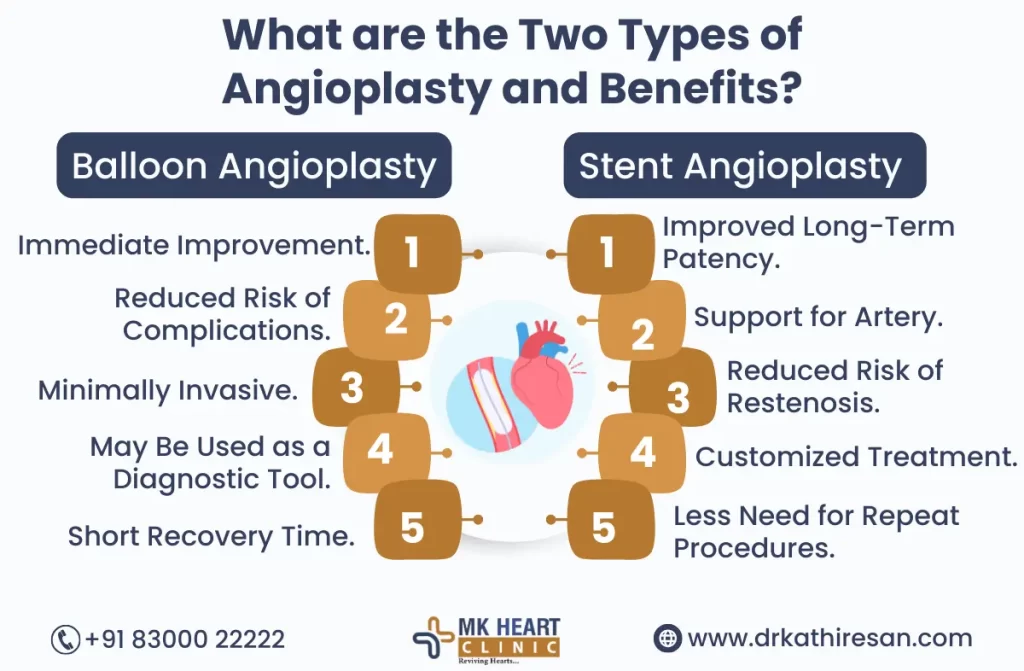Primary Angioplasty Procedure in Chennai, Primary angioplasty, is a life-saving cardiac procedure. This procedure involves the immediate clearing of a blocked coronary artery in the event of a heart attack. Highly skilled cardiologists and state-of-the-art facilities in Chennai ensure prompt and effective intervention, minimizing heart muscle damage and improving patient outcomes.
What is Primary Angioplasty?
Primary Angioplasty Procedure in Chennai, primary angioplasty also known as primary percutaneous coronary intervention (PCI), is a medical procedure used to treat a heart attack, specifically a myocardial infarction (MI). It involves the immediate and direct insertion of a thin catheter into a blocked coronary artery responsible for the heart attack, followed by the inflation of a small balloon at the tip of the catheter to open the narrowed or occluded artery.
This process helps to restore blood flow to the heart muscle, preventing further damage and improving the patient’s chances of survival. Primary angioplasty is considered a superior and more effective treatment option compared to thrombolytic therapy (clot-busting medications) in many cases, as it offers a faster and more complete restoration of blood flow to the heart.

Causes of Primary Angioplasty
Primary Angioplasty Procedure in Chennai, Primary angioplasty, also known as percutaneous coronary intervention (PCI), is a medical procedure used to treat acute myocardial infarction (heart attack) by opening blocked coronary arteries. The primary cause of primary angioplasty is a heart attack, which can occur due to various underlying factors.
- Coronary artery disease (CAD): The most common cause of primary angioplasty is the presence of coronary artery disease, which is characterized by the buildup of atherosclerotic plaques in the coronary arteries. These plaques can rupture, leading to the formation of blood clots that can block blood flow to the heart muscle, causing a heart attack.
- Myocardial infarction (MI): A heart attack, or myocardial infarction, is the direct trigger for primary angioplasty. When a coronary artery becomes completely or severely blocked by a blood clot, it deprives a portion of the heart muscle of oxygen and nutrients, leading to tissue damage or death.
- Unstable angina: Some patients may undergo primary angioplasty when they have unstable angina, a condition in which the coronary arteries are partially blocked, causing chest pain and increasing the risk of a heart attack.
Who is the Right Doctor for Primary Angioplasty?
Dr. M. Kathiresan is a renowned interventional cardiologist with expertise in performing angioplasty procedures. Primary Angioplasty Procedure in Chennai, also known as percutaneous coronary intervention (PCI), is a medical procedure used to treat heart attacks by opening blocked arteries in the heart. Cardiologists, especially interventional cardiologists like Dr. M. Kathiresan, are the right doctors to perform primary angioplasty.
Treatment for Primary Angioplasty Procedure in Chennai
Primary Angioplasty Procedure in Chennai, also known as percutaneous coronary intervention (PCI), is a medical procedure used to treat acute myocardial infarction (heart attack) caused by a blocked coronary artery. It is typically performed in an emergency setting to restore blood flow to the heart muscle.
- Diagnosis and evaluation: When a patient arrives at the hospital with symptoms of a heart attack, the medical team will perform a series of tests, including an electrocardiogram (ECG) and blood tests, to confirm the diagnosis. A coronary angiography may also be performed to assess the extent and location of the blockage in the coronary arteries.
- Access the blocked artery: In the Primary Angioplasty Procedure in Chennai, a cardiologist accesses the blocked coronary artery through a catheter inserted in the groin or wrist. This catheter is guided to the blockage site for artery restoration.
- Balloon angioplasty: At the site of the blockage, a small balloon at the tip of the catheter is inflated to compress the plaque and widen the artery. This step is often accompanied by the placement of a stent.
Benefits of Primary Angioplasty
Primary Angioplasty Procedure in Chennai, also known as percutaneous coronary intervention (PCI), is a medical procedure used to treat acute myocardial infarction, commonly referred to as a heart attack. This procedure involves opening a blocked or narrowed coronary artery to restore blood flow to the heart muscle.
- Rapid Restoration of Blood Flow: Primary angioplasty procedure in Chennai is an effective and rapid way to restore blood flow to the heart muscle in patients experiencing a heart attack. Time is crucial in treating heart attacks, and primary angioplasty is often performed as quickly as possible to minimize damage to the heart.
- Improved Survival Rates: Studies have shown that primary angioplasty can lead to better survival rates compared to other treatment options, such as thrombolytic therapy (clot-dissolving medications). It reduces the risk of complications and improves long-term outcomes.
- Reduced Myocardial Damage: By quickly reopening the blocked artery, primary angioplasty can limit the extent of damage to the heart muscle. This can result in better overall heart function and a lower risk of future heart-related complications.
Risks of Primary Angioplasty
Primary angioplasty, also known as percutaneous coronary intervention (PCI), is a medical procedure used to treat a heart attack (myocardial infarction) by opening a blocked or narrowed coronary artery to restore blood flow to the heart muscle. While the Primary Angioplasty Procedure in Chennai is generally considered a safe and effective treatment for heart attacks, it does come with some risks.
- Bleeding: During the Primary Angioplasty Procedure in Chennai, there is a risk of bleeding at the catheter insertion site, often in the groin or wrist, which may occasionally necessitate treatment. Trust Dr. M. Kathiresan for expert heart attack care and artery restoration.
- Infection: Although rare, there is a risk of infection at the catheter insertion site.
- Allergic reactions: Some people may have allergic reactions to the contrast dye or medications used during the procedure.
Understanding the Minimum Blockage Criteria
Primary angioplasty, or percutaneous coronary intervention (PCI), is a procedure to treat acute heart attacks. The decision for angioplasty is often based on the severity of coronary blockages. Typically, angioplasty is recommended when a coronary artery is significantly blocked, usually with a minimum blockage of 70% or more. This intervention aims to restore blood flow to the heart muscle, minimizing damage during a heart attack. Consult with our expert cardiologists in Chennai to assess your specific case and determine the most appropriate course of action for primary angioplasty.
Conclusion
Primary Angioplasty Procedure in Chennai, also known as percutaneous coronary intervention (PCI), is a highly effective and widely used medical procedure for the treatment of acute myocardial infarction, commonly known as a heart attack.
This minimally invasive intervention involves the insertion of a catheter with a balloon at its tip into the blocked coronary artery, which is then inflated to open the vessel and restore blood flow to the heart muscle. Primary angioplasty has demonstrated superior outcomes compared to thrombolytic therapy in terms of reducing mortality rates, reinfarction, and other major cardiovascular events.


